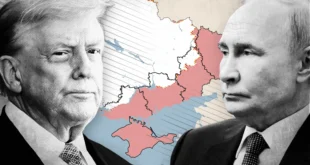Ferial Ara Saeed
Saudi Arabia and the UAE have emerged as central components in the Trump administration’s AI strategy. But interdependence carries its risks.
Red Cell
The Red Cell series is published in collaboration with the Stimson Center. Drawing upon the legacy of the CIA’s Red Cell—established following the September 11 attacks to avoid similar analytic failures in the future—the project works to challenge assumptions, misperceptions, and groupthink with a view to encouraging alternative approaches to America’s foreign and national security policy challenges. For more information about the Stimson Center’s Red Cell Project, see here.
In 2029, the world’s most advanced artificial intelligence (AI) data center will probably be in Abu Dhabi, not Silicon Valley. President Donald Trump is building the backbone of American AI dominance far from home, in a bold gambit with profound geo-strategic consequences and risks.
Data centers are critical in the race for AI dominance. Like factories, they bring together semiconductors (the parts), software (the plans), and experts (the engineers) to build and run AI systems. The United States cannot build data centers fast enough at home owing to resource, regulatory, and political constraints. Overcoming these bottlenecks requires time, money, and political commitment, with no guarantee of success.
Meanwhile, China could catch up with its all-out state-backed infrastructure push. Trump has thus opted to scale US-anchored data centers abroad, namely in the United Arab Emirates (UAE) and Saudi Arabia. To clear the way, the administration had to rescind Biden-era controls on AI chip exports, marking a decisive turn in US strategy from containment to strategic diffusion.
Details of these chips-for-infrastructure agreements are still emerging, but the terms are already clear. According to the White House, the Emiratis andSaudis will fund data centers at home and in the United States in exchange for advanced chips. American chipmaker Nvidia will supply about a millionAI chips in total, mainly to the UAE, with 80 percent earmarked for US partners, according to SemiAnalysis, an independent research firm specializing in the AI industry. The US partners—including OpenAI, Amazon, and Microsoft—will develop the data centers with the UAE’s G42 and Saudi Arabia’s Humain.
These deals create asymmetrical dependencies. Gulf allies contribute resources and will align their policies with US AI goals, driven by theirexistential need to diversify beyond fossil fuels. The United States contributes high-precision chips and implants its AI ecosystem into the region, using proprietary software and hardware that locks Gulf states into long-term reliance on American technology and maintenance.
This strategy is a win-win in the near term: Each side solves an existential problem while expanding its AI capabilities and geopolitical influence. Over the long run, however, Gulf partners could evolve into US rivals, while Washington might leverage their dependence on American technology to pursue unrelated strategic goals, reverting to a familiar playbook. This paper examines the logic behind the AI deals, the geopolitical dynamics they trigger, and the potential risks they entail.
The Win-Win
The United States faces severe obstacles in scaling AI infrastructure at home, Microsoft Azure’s Chief Technology Officer Mark Russinovichwarned last year. Data centers are staggeringly energy-intensive and costly. Acquiring permits can take years, and nondisclosure agreements conceal initial corporate talks with local officials behind closed doors, inviting public backlash. Once operational, data centers can overload electrical grids, increase utility costs, and heighten the risk of blackouts.
Yet, without them, high-precision chips are like Rolls-Royce engines sitting idle in a warehouse, not driving anything. With the global AI market projected to grow 2,500 percent between 2023 and 2033, per a United Nations report, the United States needs more data centers to meet demand and stay ahead of China.
The UAE and Saudi Arabia offer low-cost energy, regulatory flexibility, unqualified AI ambition, and access to their trillion-dollar sovereign wealth funds. These funds can shoulder the massive upfront spending anddelayed returns characteristic of AI investment because they are free fromnear-term liabilities, per the International Monetary Fund. As AI projects grow larger and costlier, the industry can also better withstand tougher credit markets. Furthermore, these deals with Gulf states generate revenue that offsets losses from economic decoupling with China.
For the Gulf states, the deals facilitate a technological leap, accelerating the UAE’s AI Strategy 2031 and Saudi Arabia’s Vision 2030. Significantly, Abu Dhabi and Riyadh will not be passive buyers of US chips, but essential partners in building the infrastructure for the next generation of American AI. The deals elevate the status of the two Gulf powers globally and among US allies.
A New Paradigm of Global Power
The Trump administration is recalibrating the role Gulf allies play in US foreign policy, describing them as an undervalued asset—a view the president affirmed during his May 13 visit to Riyadh. The Gulf is reinventing itself, prioritizing economic diversification, technological advancement, and détente over conflict and confrontation. The UAE and Saudi Arabia havenormalized relations with Iran and lowered other regional tensions, seeking to become hubs of innovation and regional integration. Where past administrations viewed both countries as peripheral, apart from their energy resources, Trump sees them as central to projecting influence in the digital age.
The hierarchy of American alliances is being quietly but decisively reshuffled. Gulf states are rising in importance because of their strategic value in the AI race, tempered by their deepening ties to China and potential future political divergence from the United States. Nonetheless, Washington recognizes that sustaining AI dominance requires interdependent networks of US infrastructure abroad. Where this leaves Europe and Asia is unclear. Neither region can currently match the Gulf’s speed, flexibility, and resources. Furthermore, these high-stakes Gulf partnerships are unfolding alongside an ongoing US conflict with Iran, signaling an ironic American recommitment to the Middle East that undermines Washington’s long-planned pivot to Asia.
Although the administration maintains its rhetorical commitment to that strategy, with limited capacity to sustain intensive engagement on multiple fronts, trade-offs are inevitable. Yet Asia’s continued importance to the United States is undeniable and complex. Despite regional anxieties over China’s rise, even close US allies like Japan and South Korea are economically integrated with the People’s Republic. They seek deeper US involvement in the region to balance China, yet resist exclusive alignment with the United States. Washington has struggled to accept that the region cannot evict China or ignore it. In contrast, despite Beijing’s growing importance in the Gulf, Riyadh and Abu Dhabi are willing to divest or have divested when pressured by Washington.
America’s allies—and competitors—must thus contend with the Gulf as an emerging power in the global AI race. This shift could reshape how influence is built and exercised. The old order was structured around trade agreements and military alliances. The new one may increasingly rest oncompute—the computational resources and processes required to train and run AI systems—and control over where and how AI models are trained. In this emerging framework, power flows more from infrastructure than ideology.
The wrench in this strategy would be the collapse of the Israel-Iranceasefire and a protracted US-Israeli conflict with Tehran. Resumption of hostilities would delay or cancel Gulf-based infrastructure projects. US-affiliated AI centers would become political liabilities or even strategic targets, shattering investor confidence.
Critics also rightly warn that partnering with “authoritarian” Gulf regimes could encode illiberal values into the digital systems of the future. This concern deserves serious consideration. Yet it must be weighed against the reality that Western democracies themselves are building platforms fordigital surveillance and increasingly curtailing freedoms at home, while selectively applying the “rules-based order” abroad. Furthermore, strategic exclusion is a nonstarter when neither Gulf partner is abandoning Chinesesoftware altogether. These partnerships give Washington a foothold to shape the global digital commons from within.
Nonetheless, they carry risks that could erode the very influence they aim to build.
Related Articles
Alignment Today, Regret Tomorrow?
The sharpest critique of Trump’s AI strategy is that the deals give America’s crown jewels to partners who may defect or become competitors. AI chips are not just about chatbots—they can shift the global balance of power. The UAE and Saudi Arabia are not treaty allies; they maintain relationships withUS adversaries like China, Russia, and Iran.
However, the near-term risk of competition is overstated. The non-US portion of the deals is tiny. Furthermore, the Gulf states cannot buildfrontier AI models or global infrastructure without US support. The risk of defection is also low: China cannot build data centers abroad because its advanced chipmaking capacity lags behind the United States. Beijing cannot support projects at this scale without producing competitive volumes of chips with comparable performance. For now, a truly transformative leap in AI requires partnership with the United States.
These deals are not a handover of power, but a careful extension of it. The two Gulf allies host a combined 6,000 US troops and contractors. They have strong historical records of security cooperation with Washington. Over the long term, they could become direct US competitors or defect from their alliance with the United States. The alternative, however, is that China achieves AI parity and spreads its technology stack far and wide, accumulating the influence to set the world’s digital rules, standards, and norms. Trump’s deals with the UAE and Saudi Arabia seek to lock in today’s strategic advantage before the balance tips.
The risk of technology diversion remains real, yet the deals offer little transparency around governance, physical and cybersecurity, and enforcement, such as whether the United States will retain root-level access or real-time visibility into operations at Gulf-based centers. Still, these risks can be mitigated through strict know-your-customer protocols, continuous US monitoring, bans on third-party transfers, and adherence to US-approved safety standards, among other measures.
Even if its AI partners remain aligned with US interests, however, the temptation for Washington to weaponize their dependence in order to pursue unrelated strategic goals will be hard to resist.
Trust and the Digital Deep State
Mitigating the risk of weaponization requires restraint from Washington. The Gulf deals worsen this challenge with the fusion of state and corporate power. This new “digital deep state” is not China’s state-directed model, but rather an informal alliance that can erode trust just as effectively.
US technology firms have enjoyed a competitive edge not just in terms of performance or price, but also in the perception of independence from government control, unlike their Chinese rivals, whose ties to the Communist Party are explicit. Upending that perception has costs. Silicon Valley giants took a big hit after the 2013 Snowden revelations exposed their ties to government spying, as Wired reported. Europe’s response shows that trust, once lost, is hard to regain, with stricter data privacy laws, aggressive regulation of American competitors, stronger data governance laws, and investment in domestic chip and cloud infrastructure.
If Washington weaponizes these infrastructure partnerships, it risks a broader rejection of US platforms. China markets itself as a “noninterventionist” alternative. Beijing argues that Huawei’s surveillance risks are predictable and transactional. Furthermore, unlike the United States, China does not demand political conformity.
For many middle powers, that may be a compelling pitch. A second-best chip without political strings could be more attractive than the latest Nvidia graphics processing unit wrapped in geopolitical red tape. If enough countries engaged in widespread hedging by dual-sourcing their infrastructure—which the Gulf deals inhibit by using proprietary platforms and maintenance—US influence would erode.
Ultimately, the success of this strategy will depend on more than chips and contracts. It will depend on how the United States manages power and trust.
The Challenge: Influence Without Overreach
President Trump’s pivot to the Gulf to expand American AI infrastructure marks a bold departure from a US strategy once grounded in containment and control. By outsourcing the physical core of AI development to Abu Dhabi and Riyadh, Washington addresses urgent domestic constraints and acknowledges a harsh reality: American AI leadership no longer depends solely on Silicon Valley or traditional allies in Europe and Asia. Instead, it relies on strategic interdependence with partners that are willing to underwrite the future of American digital power. In this way, a US-centric digital order can take shape.
Yet there are risks, some that can only be managed, not mitigated. Today’s Gulf partners—the UAE and Saudi Arabia—could one day become competitors, and Washington could weaponize their dependence. Either risk would unravel the dominance the United States aims to secure.
The future of US leadership in this emerging bipolar order thus hinges on mastering a paradox: influence without overreach. Today, power flows through code and compute, not just treaties and troops. AI infrastructure has become destiny. Where it is anchored will define the global balance of power and establish which country dominates for decades to come.
About the Author: Ferial Ara Saeed
Ferial Ara Saeed is a nonresident fellow at the Stimson Center and a former senior American diplomat. She is the founder of Telegraph Strategies LLC, a consulting firm.
Image: Shutterstock.com.
Related Articles
 Geostrategic Media Political Commentary, Analysis, Security, Defense
Geostrategic Media Political Commentary, Analysis, Security, Defense





